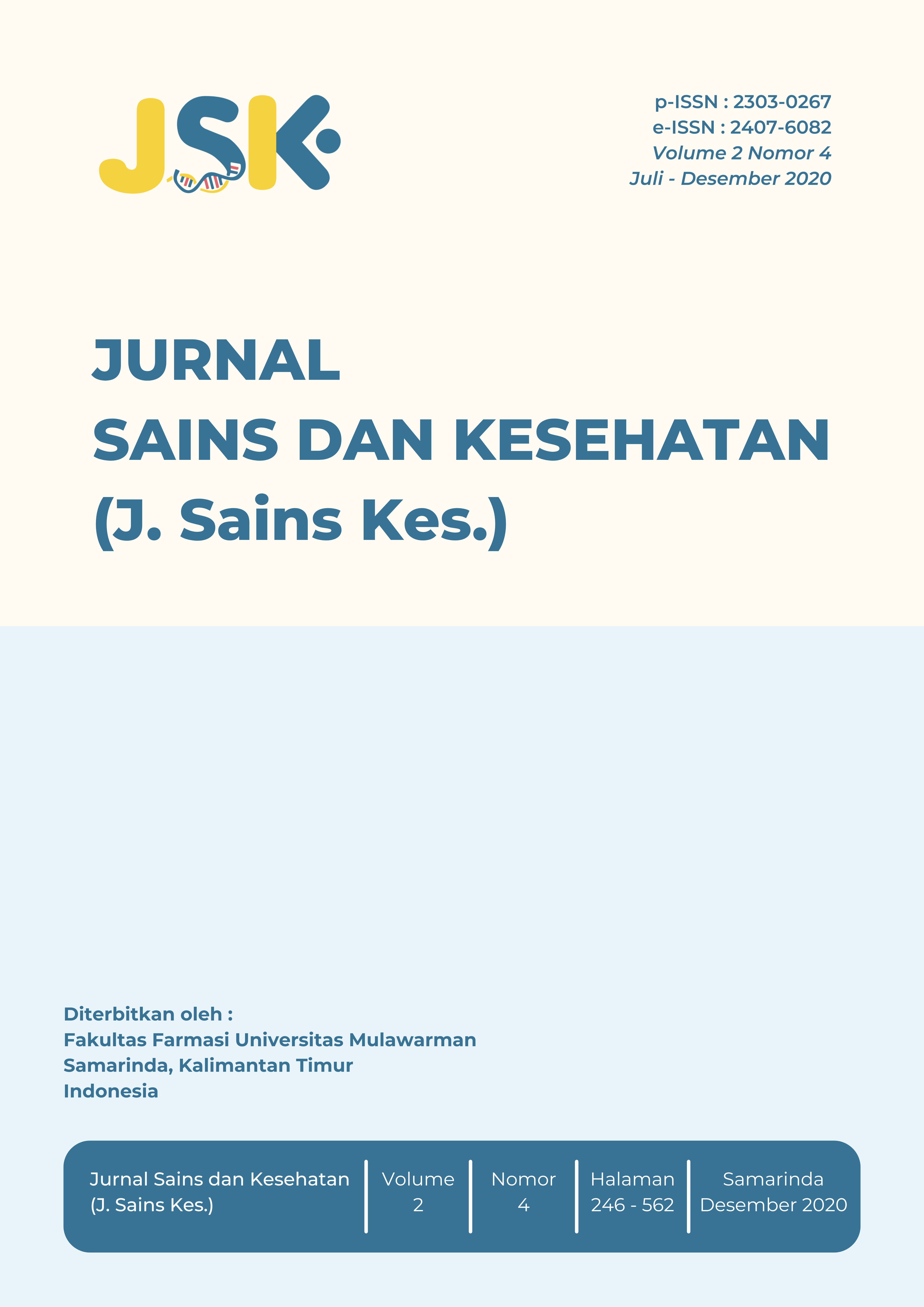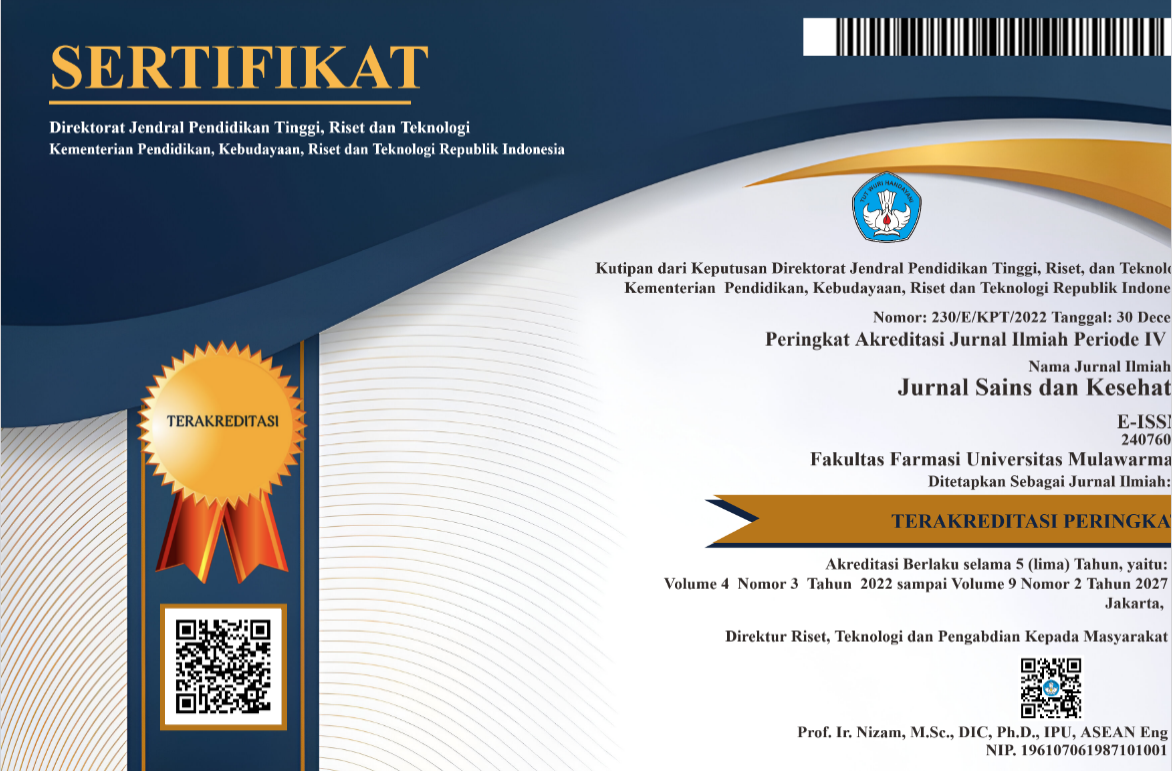Peranan Sel Limfosit Dalam Imunulogi: Artikel Review
Keywords:
Limfosit, Imunologi, Imunitas AdaptifAbstract
imunitas adaptif. Pada artikel review ini dijelaskan berbagai bentuk limfosit dan peran imunomodulatornya
dalam kesehatan dan penyakit.
References
O. Orakpoghenor, D. O. Avazi, T. P. Markus, and O. S. Olaolu, “Lymphocytes : A Brief Review -,” vol. 3, no. June, pp. 4–8, 2019.
G. Rosario-p, “The development of B lymphocytes Introduction,” Universiteit Utrecht, 2009.
Y. Dachlan, “Immune System. Course Material. Doctoral Program,” Faculty of Medicine : Airlangga University, 2019.
M. D. Cooper and J. F. A. P. Miller, “Discovery of 2 Distinctive Lineages of Lymphocytes, T Cells and B Cells, as the Basis of the Adaptive Immune System and Immunologic Function: 2019 Albert Lasker Basic Medical Research Award,” JAMA - Journal of the American Medical Association, vol. 322, no. 13. pp. 1247–1248, 2019.
J. I. Castañeda-sánchez, A. Rosa, M. Duarte, M. L. Domínguez-lópez, J. J. De Cruz-lópez, and J. Luna-herrera, “Lymphocyte Updates - Cancer, Autoimmunity and Infection,” Lymph. Updat. - Cancer, Autoimmun. Infect., 2017, doi: 10.5772/66613.
N. Baumgarth, J. W. Tung, and L. A. Herzenberg, “Inherent specificities in natural antibodies: A key to immune defense against pathogen invasion,” Springer Seminars in Immunopathology, vol. 26, no. 4. pp. 347–362, 2005.
K. Hayakawa, R. R. Hardy, L. A. Herzenberg, and L. A. Herzenberg, “Progenitors for Ly-1 b cells are distinct from progenitors for other b cells,” J. Exp. Med., vol. 161, no. 6, pp. 1554–1568, 1985.
N. Baumgarth, “The double life of a B-1 cell: Self-reactivity selects for protective effector functions,” Nat. Rev. Immunol., vol. 11, no. 1, pp. 34–46, 2011.
N. Solvason et al., “Cyclin d2 is essential for BCR-mediated proliferation and CD5 B cell development,” Int. Immunol., vol. 12, no. 5, pp. 631–638, 2000.
E. Montecino-Rodriguez and K. Dorshkind, “B-1 B Cell Development in the Fetus and Adult,” Immunity, vol. 36, no. 1, pp. 13–21, 2012, doi: 10.1016/j.immuni.2011.11.017.
M. Y. Chou et al., “Oxidation-specific epitopes are dominant targets of innate natural antibodies in mice and humans,” J. Clin. Invest., vol. 119, no. 5, pp. 1335–1349, 2009.
L. Kulik et al., “Pathogenic Natural Antibodies Recognizing Annexin IV Are Required to Develop Intestinal Ischemia-Reperfusion Injury,” J. Immunol., vol. 182, no. 9, pp. 5363–5373, 2009.
F. Martin, A. M. Oliver, and J. F. Kearney, “Marginal zone and B1 B cells unite in the early response against T-independent blood-borne particulate antigens,” Immunity, vol. 14, no. 5, pp. 617–629, 2001.
N. Baumgarth, “The double life of a B-1 cell: Self-reactivity selects for protective effector functions,” Nat. Rev. Immunol., vol. 11, no. 1, pp. 34–46, 2011.
Y. S. Choi and N. Baumgarth, “Dual role for B-1a cells in immunity to influenza virus infection,” J. Exp. Med., vol. 205, no. 13, pp. 3053–3064, 2008.
K. Suzuki, M. Maruya, S. Kawamoto, and S. Fagarasan, “Roles of B-1 and B-2 cells in innate and acquired IgA-mediated immunity,” Immunological Reviews, vol. 237, no. 1. pp. 180–190, 2010.
L. A. De-Gennaro, A. F. Popi, S. R. de Almeida, J. D. Lopes, and M. Mariano, “B-1 cells modulate oral tolerance in mice,” Immunol. Lett., vol. 124, no. 2, pp. 63–69, 2009.
C. H. Kim, “B cell-helping functions of gut microbial metabolites,” Microb. Cell, vol. 3, no. 10, pp. 529–531, 2016.
P. Shen et al., “IL-35-producing B cells are critical regulators of immunity during autoimmune and infectious diseases,” Nature, vol. 507, no. 7492, pp. 366–370, 2014.
U. M. Selvaraj, K. Poinsatte, V. Torres, S. B. Ortega, and A. M. Stowe, “Heterogeneity of B Cell Functions in Stroke-Related Risk, Prevention, Injury, and Repair,” Neurotherapeutics, vol. 13, no. 4. pp. 729–747, 2016.
[K. A. Young, X. S. Chen, V. M. Holers, and J. P. Hannan, “Isolating the Epstein-Barr virus gp350/220 binding site on complement receptor type 2 (CR2/CD21),” J. Biol. Chem., vol. 282, no. 50, pp. 36614–36625, 2007.
O. L. Hatton, A. Harris-Arnold, S. Schaffert, S. M. Krams, and O. M. Martinez, “The interplay between Epstein-Barr virus and B lymphocytes: Implications for infection, immunity, and disease,” Immunol. Res., vol. 58, no. 2–3, pp. 268–276, 2014.
U. C. Meier, G. Giovannoni, J. S. Tzartos, and G. Khan, “Translational Mini-Review Series on B cell subsets in disease. B cells in multiple sclerosis: Drivers of disease pathogenesis and Trojan horse for Epstein-Barr virus entry to the central nervous system?,” Clinical and Experimental Immunology, vol. 167, no. 1. pp. 1–6, 2012.
K. Nothelfer, P. J. Sansonetti, and A. Phalipon, “Pathogen manipulation of B cells: The best defence is a good offence,” Nature Reviews Microbiology, vol. 13, no. 3. pp. 173–184, 2015.
Y. Souwer et al., “B Cell Receptor-Mediated Internalization of Salmonella : A Novel Pathway for Autonomous B Cell Activation and Antibody Production,” J. Immunol., 2009.
K. Kubelkova and Z. Krocova, “the Role of B Cells in Intracellular,” in B cells: Molecular Biology, Developmental Origin and Impact on the Immune System, Cell Biolo., no. October, L. R. Robert L. Montes, Ed. Nova Science Publishers, 2013, pp. 1–43.
C. A. J. Vosshenrich, A. Cumano, W. Müller, J. P. Di Santo, and P. Vieira, “Pre-B cell receptor expression is necessary for thymic stromal lymphopoietin responsiveness in the bone marrow but not in the liver environment,” Proc. Natl. Acad. Sci. U. S. A., vol. 101, no. 30, pp. 11070–11075, 2004.
T. Nagasawa, “Microenvironmental niches in the bone marrow required for B-cell development,” Nature Reviews Immunology, vol. 6, no. 2. pp. 107–116, 2006.
D. C. Hargreaves et al., “A coordinated change in chemokine responsiveness guides plasma cell movements,” J. Exp. Med., vol. 194, no. 1, pp. 45–56, 2001.
M. R. Ehrenstein and C. A. Notley, “The importance of natural IgM: Scavenger, protector and regulator,” Nature Reviews Immunology, vol. 10, no. 11. pp. 778–786, 2010.
H. De Haard, “The Development of B Lymphocytes,” Universiteit Utrecht, 2010.
A. P. Immunopaedia, Bellanti JA, Taylor, “Overview of T Cell Subsets,” Basics Immune Syst., 2017.
Y. Chien, C. Meyer, and M. Bonneville, “ γδ T Cells: First Line of Defense and Beyond ,” Annu. Rev. Immunol., vol. 32, no. 1, pp. 121–155, 2014.
E. J. Adams, Y. H. Chien, and K. C. Garcia, “Structure of a γδ T cell receptor in complex with the nonclassical MHC T22,” Science (80-. )., vol. 308, no. 5719, pp. 227–231, 2005.
Y. Cai et al., “Pivotal Role of Dermal IL-17-Producing γδ T Cells in Skin Inflammation,” Immunity, vol. 35, no. 4, pp. 596–610, 2011.
M. Bonneville, R. L. O’Brien, and W. K. Born, “γ δ T cell effector functions: A blend of innate programming and acquired plasticity,” Nature Reviews Immunology, vol. 10, no. 7. pp. 467–478, 2010.
C. Nathan, “Neutrophils and immunity: Challenges and opportunities,” Nature Reviews Immunology, vol. 6, no. 3. pp. 173–182, 2006.
Downloads
Published
Issue
Section
How to Cite
Similar Articles
- Muhammad Saiful Mu'min, Maria Ulfah, Aktivitas Imunomodulator Ekstrak Etanol Daun Kedondong (Spondias Pinnata) (L.F) Kurz) terhadap Proliferasi Sel Limfosit Mencit Balb/C beserta Uji Kandungan Flavonoid , Jurnal Sains dan Kesehatan: Vol. 5 No. SE-1 (2023): Spesial Edition J. Sains Kes.
- Flora Ramona Sigit Prakoeswa , Faradiba Maharani , Peran Disregulasi Imunitas dalam Terapi Kusta pada Area Endemis: Artikel Review , Jurnal Sains dan Kesehatan: Vol. 4 No. 1 (2022): J. Sains Kes.
- Yasmiwar Susilawati, Moelyono Moektiwardoyo, Eli Halimah, Imam Adi Wicaksono, Zelika Mega Ramadhania, Silvia Sari Prastiwi, Aktivitas Imunomodulator Ekstrak Etanol Daun Pepaya (Carica papaya L.) dengan Metode Induksi Bakteri dan CBC-Diff , Jurnal Sains dan Kesehatan: Vol. 2 No. 4 (2020): J. Sains Kes.
- Risna Agustina, Abdul Mun’im, Gemini Alam, Azminah Azminah, Angga Cipta Narsa, Hadi Kuncoro, M. Arifuddin, Wisnu Cahyo Prabowo, Noor Linda Febrianie, Erwin Samsul, Iswahyudi Iswahyudi, Islamudin Ahmad, Aktivitas Hemaglutinasi dan Identifikasi Ekstrak Berbasis Green Solvent dari Akar Tapak Dara (Vinca rosea) dan Daun Kadamba (Mitragyna speciosa Korth. Havil) Menggunakan FTIR-Kemometrik , Jurnal Sains dan Kesehatan: Vol. 4 No. 5 (2022): J. Sains Kes.
- Nurmalia Zakaria, Fauziah Fauziah, Rinaldi Rinaldi, Yuni Dewi Safrida, Erliana Winingsih, Analisa Fitokimia dan Aktivitas Antioksidan Sirup Poliherbal yang Mengandung Daun Kelor, Rimpang Kunyit, dan Rimpang Jahe , Jurnal Sains dan Kesehatan: Vol. 5 No. 1 (2023): J. Sains Kes.
- Helman Kurniadi, Ros Sumarny, Timbul Partogi Haposan Simorangkir, Syamsudin Abdillah, Faktor-Faktor yang Berhubungan dengan Komplikasi Apendisitis dan Efektivitas Penggunaan Antibiotik Profilaksis pada Pasien Apendektomi di RSPAD Gatot Soebroto , Jurnal Sains dan Kesehatan: Vol. 5 No. 6 (2023): J. Sains Kes.
- Nurnadhirah Mirantika, Danial Danial, Bambang Suprapto, Hubungan antara Usia, Lama Keluhan Nyeri Abdomen, Nilai Leukosit, dan Rasio Neutrofil Limfosit dengan Kejadian Apendisitis Akut Perforasi di RSUD Abdul Wahab Sjahranie Samarinda , Jurnal Sains dan Kesehatan: Vol. 3 No. 4 (2021): J. Sains Kes.
- Bulan Rosita Sari, Winni Nur Auli, Vita Julia Saputri, Okta Dinata Saputri, Alika Putriyana Boru Tumanggor, Dhea Anggun Ferlinda, Fira Anggraini, Fatonah Fatonah, Studi In Silico Potensi Antikanker Leukemia Limfositik Senyawa Alkaloid Indol terhadap Protein BCL-2 , Jurnal Sains dan Kesehatan: Vol. 5 No. 5 (2023): J. Sains Kes.
You may also start an advanced similarity search for this article.




